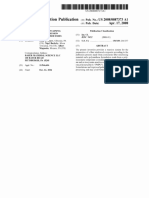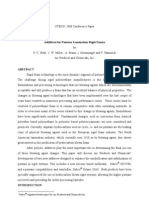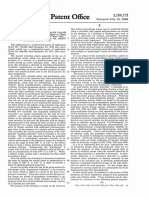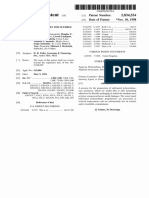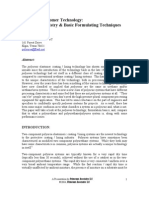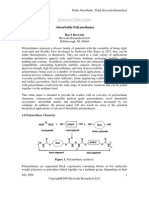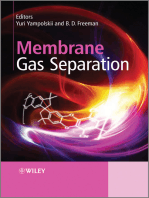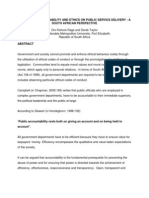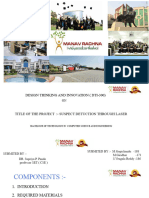0 ratings0% found this document useful (0 votes)
2 viewsUS4605684 PU Anti-Stat
US4605684 PU Anti-Stat
Copyright:
© All Rights Reserved
Available Formats
Download as PDF, TXT or read online from Scribd
US4605684 PU Anti-Stat
US4605684 PU Anti-Stat
0 ratings0% found this document useful (0 votes)
2 views7 pagesCopyright
© © All Rights Reserved
Available Formats
PDF, TXT or read online from Scribd
Share this document
Did you find this document useful?
Is this content inappropriate?
Copyright:
© All Rights Reserved
Available Formats
Download as PDF, TXT or read online from Scribd
Download as pdf or txt
0 ratings0% found this document useful (0 votes)
2 views7 pagesUS4605684 PU Anti-Stat
US4605684 PU Anti-Stat
Copyright:
© All Rights Reserved
Available Formats
Download as PDF, TXT or read online from Scribd
Download as pdf or txt
You are on page 1of 7
United States Patent (19) 11) Patent Number: 4,605,684
Pcolinsky, Jr. 45 Date of Patent: Aug. 12, 1986
(54) ANTISTATIC POLYURETHANE FOAM 57 ABSTRACT
76) Inventor: Michael P. Pcolinsky, Jr., 1009 Flexible polyurethane foams having improved electro
Meade Ct., Hazleton, Pa. 18201 static properties are provided by incorporating into the
21 Appl. No.: 793,163 reaction mixture before foaming an antistatic additive
composition comprising a blend of a quaternary ammo
22 Filed: Oct. 31, 1985 nium compound selected from the group consisting of
51) Int. Cl." ................................................ C08J 9/00 soya dimethyl ethyl ammonium ethylsulfate, soya di
52 U.S. Cl. ................. ... 521/107; 521/121 methyl ethyl ammonium phosphate, and mixtures
58) Field of Search ................................ 521/107, 121 thereof, and a plasticizer composition selected from the
(56) References Cited group consisting of N-ethyl-o- and p-toluene sulfona
U.S. PATENT DOCUMENTS
mide, o- and p-toluene sulfonamide, and tetrakis (2 chlo
roethyl) ethylene diphosphate, and mixtures thereof.
4,169,922 10/1979 Brown ................................. 521/107
Primary Examiner-Morton Foelak 9 Claims, No Drawings
1.
4,605,684
2
tics of packaging materials used for a variety of sensitive
ANTISTATIC POLYURETHANE FOAM electronic components and devices are set forth in the
military specification Mil. No. B 81705B.
This invention relates to flexible polyurethane foams It is known that certain quaternary ammonium salts
exhibiting enhanced antistatic properties, that is, foams can be added during the manufacture of polyurethane
which rapidly dissipate electrostatic charges and exhibit foam to impart improved antistatic properties to the
a reduced tendency to accumulate electrostatic charges. cured foam. U.S. Pat. No. 3,933,697 discloses specific
The flexible polyurethane foams can be produced by quaternary ammonium salts that can be incorporated as
reactions of isocyanates with polyester polyols, poly an ingredient into the composition prior to commence
ether polyols, mixtures of polyether and polyester poly 10 ment of the foam-forming reaction; alternatively, it is
ols, or with mixtures of polyether polyols and copoly suggested that the same compounds can be applied by
mer polyols, such as a grafted polyether containing impregnation to the finished urethane foam.
styrene and acrylonitrile. While the advantages of incorporating an additive by
BACKGROUND OF THE INVENTION the in-situ method which will render the finished prod
15 uct antistatic are obvious, the selection of appropriate
Polyurethane foams, like almost all other synthetic materials must be based upon their compatibility in the
polymeric materials, tend to acquire and accumulate foam making process, and on their effect on the physical
electrostatic charges. For many applications it is desir appearance and characteristics of finished foam prod
able, if not essential, to have a foam material which uct. This is so because the foam-forming reaction re
either does not acquire an electrostatic charge, or which 20 quires a careful balancing of the polymerization, or
dissipates it rapidly. gellation, reaction with the expansion of the foam-form
Accumulation of electrostatic changes on all types of ing ingredients to provide a uniform cell structure, the
polymeric materials has been a long-standing problem, avoidance of splits, cracks and other defects, and finally
and a variety of techniques have been proposed to alle the polymerization which must be completed within a
viate the problem. For example, additives which mi 25 critical time period to insure a self-sustaining and stable
grate to the surface of the plastic or fiber have been foam structure. The presence of even small quantities of
incorporated in the composition to modify its electrical additional compounds can have a markedly adverse
properties. Antistatic resins have been copolymerized effect on the reaction mechanism and the finished prod
with the base polymer in an effort to provide improved uct. Those familiar with the art will know of the ad
properties. Quaternary ammonium salts have been ap 30 verse effects of low levels of contaminants or impurities
plied topically, i.e., by impregnation, or incorporated which may be barely detectable.
directly into the polymeric materials to provide a fin It is therefore essential in seeking an agent or additive
ished, or semi-finished product with improved antistatic which will render the finished foam antistatic, to find a
properties. For example, U.S. Pat. No. 3,117,113 with a compound or composition that is totally compatible
priority filing date in 1957, discloses the use, in combi 35 with the foam making process. Other factors which
nation with PVC, of quaternary, ammonium compounds must be taken into account are (1) the ability to mechan
of the general class found useful in this invention. U.S. ically incorporate the antistatic additive into the foam
Pat. Nos. 3,335,123 and 3,407,187 disclose the use of forming composition using conventional equipment;
quaternary ammonium compounds which are physi and (2) the cost of the additive at its effective level or
cally incorporated into polyolefins, PVC and other 40 within its effective range and its impact on the final cost
polymers, as by milling. None of these patents suggests of the foam.
the introduction of the quaternary ammonium com SUMMARY OF THE INVENTION
pounds into the reaction mixture prior to polymer for
mation. It has now been found that certain quaternary ammo
Polyurethane foam can be provided with antistatic 45 nium compounds, when combined with plasticizers, and
properties by one of two methods: (1) the in-situ pro preferably those plasticizers which are liquids, form a
duction of an antistatic foam that has uniform properties solution which can be incorporated into the polyure
throughout its volume and cross-section; and (2) a post thane foam making composition to provide remarkably
treatment method in which an antistatic composition is improved antistatic properties in the finished foam
impregnated on the surface and, to the extent possible, 50 product.
throughout the interior structure of the foam product. The quaternary ammonium compounds found to
The latter technique is the less preferable since it re produce a synergistic result in the practice of this inven
quires repeated handling and treatment of material tion are commercial products.
thereby increasing its cost; it provides less uniform One of the quaternary ammonium compounds found
properties, which properties may indeed be only super 55 to be useful in the practice of the invention is soya di
ficial if the thickness of the foam material is substantial; methyl ethyl ammonium ethylsulfate, and specifically
and the impregnant is subject to removal by wear and the product sold under the trademark Larostat 264-A
tear if the impregnated product is used over again. If by Jordan Chemical Company of Folcroft, Pa. The
used for packing sensitive electronic components, such product is a waxy solid which can be converted to a
as computer chips, the impregnated composition may 60 pourable liquid by heating to 50° C.-65 C. Jordan
attach to, and damage the article. Of course, in some Chemical markets this product in the form of a liquid
applications such as laundry softeners or antistatic blend of the quaternary ammonium compound in
agents, it is intended that the impregnated foam lose its twenty percent dipropylene glycol (DPG) as Larostat
antistatic coating as it is transferred to the damp laundry 377, and it can also be used in the practice of the inven
during use in the dryer. However, in most applications 65 tion. Another quaternary ammonium compound found
it is desirable for the foam product to exhibit both per to be useful in the practice of the invention is soya di
manent and uniform antistatic properties which will methyl ethyl ammonium ethylphosphate, and specifi
render the product electrostatic free. The characteris cally the product sold under the trademark Larostat 192
4,605,684 4.
3
by Jordan Chemical. This product is a pourable liquid In a preferred embodiment of the invention the qua
which can be mixed with the other components to pro-. ternary ammonium composition of Larostat 264-A,
duce the antistatic additive composition which are in which is a waxy solid at room temperature, is heated to
corporated into the foam-forming mixture. The pre between about 50 C. and 65 C., and when it melts and
ferred quaternary ammonium compound is the soya is flowable, is poured into the liquid plasticizer, which is
dimethyl ethyl ammonium ethylsulfate of Larostat 264 preferably the N-ethyl-o- and p-toluene sulfonamide
A. mixture of Santicizer 8. This mixture is then drum rolled
The plasticizers of this invention found to provide the or mixed with an impeller for a short time to obtain a
markedly improved antistatic properties when used in clear homogeneous solution. This mixture is stable and
combination with the above quaternary ammonium 10 no phase separation is observed at high or low tempera
compounds are also commercially available products. tures.
The plasticizer compositions found to be useful in the The quaternary ammonium composition of Larostat
practice of this invention are as follows: the mixture of 264-A can also be blended into other plasticizers or into
N-ethyl-o- and p-toluene sulfonamide, sold by Mon polyols using the same general procedure. In some in
santo Chemicals under the trademark Santicizer 8; the 15 stances, some phase separation may be observed as the
mixture of o- and p-toluene sulfonamide, sold by Mon mixture cools. Any phase separation which does occur
santo Chemicals under the trademark Santicizer 9; and can be minimized, if not eliminated entirely, by main
tetrakis(2 chloroethyl) ethylene diphosphate sold by taining the mixture at a higher than normal temperature.
Olin Chemical Company under the trademark Thermo As will be apparent to one skilled in the art, adjustments
lin 101. Santicizer 8 is the preferred plasticizer com 20 to the foam formulation can be made to take account of
pound and is a light yellow, viscous liquid, which is a the higher temperature of the foam forming composi
mixture of the ortho and para isomers. Santicizer 9 is a tion and reaction.
white to light-cream granular solid, also a mixture of the As noted above, the antistatic additive composition of
ortho and para isomers. The Thermolin 101 product is a this invention is added to the foam-forming reactants at
liquid, and has utility as both a plasticizer and a flame 25 the time of mixing. It can be combined in a prepolymer
retardant. mix, or added as a separate metered stream in accor
In the examples which follow, the various quaternary dance with techniques well-known to those familiar
ammonium compounds and plasticizers which were with the art. Noticeable improvements have been ob
used are, for convenience, identified by their commer served with the incorporation of from about 5 to about
cial names, or abbreviations. 30 25 parts of antistatic additive solution per 100 parts of
Most significant is the discovery that quaternary am polyol or resin. The term resin as used here is synony
monium compounds, which are solids at ambient tem mous with polyol and includes polyester and polyether
perature and pressure, when dissolved with plasticizers polyols, and mixtures thereof. The term "phr” means
to provide an antistatic additive composition, exhibit a "parts per hundred of resin.” The preferred level of
synergistic effect when added to the foam-forming reac 35 antistatic additive solution is from about 17 to 22 parts
tants and provide a finished foam having greatly im per 100 parts of polyol.
proved antistatic properties. This synergism is demon The polyurethane foams of this invention can be
strated by the fact that when only the quaternary am manufactured by the one-shot or prepolymer methods,
monium compounds alone, or the plasticizers of the and can consist of polyester polyols, polyether polyols,
invention are added to the foam-forming mixture no 40 or polyurethanes prepared from a blend of polyester
significant improvement of antistatic properties in the and polyether polyols, and of blends of polyether and
finished foam are observed. Polyurethane foams made copolymer polyols, all of which are described in more
with one or the other of the compounds exhibit essen detail below.
tially the same antistatic properties as foam containing Polyurethane foams exhibiting improved antistatic
no antistatic additives. 45 properties have many applications including use in op
The preferred combination of quaternary ammonium erating rooms where sparks can present a serious fire
salts and plasticizers of this invention provide a stable hazard; in connection with sound proofing and vibra
solution, that is, one which does not separate on stand tion damping materials for computers; and in the pack
ing, solidify on cooling or produce a precipitate. The aging and handling of sensitive electronic components
stability of the antistatic additive solution is extremely 50 such as computer chips where the presence of static
important from the standpoint of commercial produc electricity can modify or damage the article so that it
tion. Polyurethane foams are made by continuous cast cannot be used.
ing methods which are capable of, and are most efficient In the examples which follow the polyether polyol
when they are run for several hours, or throughout an resin used had an average molecular weight of 3500,
entire shift. Additive streams must be fed from storage 55 unless otherwise indicated. The copolymer polyol was a
vessels to the mixing head throughout this period. Such grafted polyether polyol containing copolymerized
additives must be stable over the daily production per styrene and acrylonitrile, which was supplied by Dow
iod, and preferably should be stable over periods of at Chemical U.S.A. under the designation XAS-10963.01.
least several days. The preferred antistatic additive Other copolymer polyols which can be used in this
solutions of this invention meet those criteria. 60 invention are available from Union Carbide Corp. and
The antistatic additive solutions of this invention are from BASF Wyandotte.
prepared by mixing one part by weight of the quater The polyester resin has an average molecular weight
nary ammonium compound in from about 0.4 part to of 2000.
three parts of liquid or solid plasticizer. Significantly The isocyanate used was tolylene diisocyanate, (also
enhanced antistatic properties have been obtained when 65 referred to as toluene diisocyanate, or simply TDI)
the antistatic additive composition is comprised of one which was an isomeric mixture of the 2,4 isomer (67%)
part of quaternary ammonium compound and one and and the 2,6 isomer (33%.) In some instances the iso
one-half parts of plasticizer. meric mixture of the TDI was 80/20, respectively. Un
5
4,605,684
6
less otherwise indicated, the TDI Index was 105. The TABLE I-continued
utility of the invention is not limited to any particular
isomeric ratio, or to any specific TDI Index value. Amine Catalyst (33-LV) 0.10-0.125 phr.
Other isocyanates conventionally used in the manufac
ture of polyurethane foams can be used. These would 5 In the examples, the total quantity of these com
include 4,4'-diphenylmethane diisocyanate (MDI), and pounds is relatively small compared to the other ingre
others well-known to those familiar with the art. dients. As is well known to those familiar with the art,
DETAILED DESCRIPTION OF THE their selection and the actual quantities employed are
INVENTION routinely varied in response to the ambient conditions
10 of temperature and humidity, as well as the mechanical
In the comparative the basic foam formulations are conditions relating to foam manufacture. In the interests
selected from those known in the art, and the individual of exemplifying the invention, the total quantity of these
components are commonly available and widely used. components identified in Table I appears in the Compo
Similarly, in those examples which illustrate the nents column adjacent the entry "Catalyst, etc.'
claimed invention, apart from the novel combination of TEST METHOD
quaternary ammonium compounds and plasticizers
which produce the improved electrostatic properties in In determining the antistatic properties of the poly
the finished foams, the components and their relative urethane foams described in the examples which follow,
proportions are assumed to be well within the skill of 20 the static decay rate method as described in Federal
the art. Test Method Standard No. 101C-4046.1 was used. In
The following components used in the examples are general, this test method is used to determine the elec
identified as follows: trostatic properties of materials in film and sheet form
1. Amine catalysts by measuring the intensity and polarity of an induced
A-1, 70% bis(2 dimethylaminoethyl) ether in DPG 25 charge and the time required for dissipation of the
sold by Union Carbide Corp. charge. In this test procedure, a static charge of 5000
A-30, silicone amine sold by Union Carbide volts is first applied across the foam sample and then the
33-LV, 33% triethylene diamine in DPG sold by voltage source is removed and the sample is grounded.
Air Products Corp. The foam sample and the test chamber are maintained at
NCM, N-coco morpholine sold by Lonza Chemi 30
a relative humidity of about 15%. The time of static
cal decay to zero volts is determined from a moving paper
16-D, N-hexadecylmethyl amine sold by Lonza chart on which the drop in voltage is recorded. A value
Chemical of less than 2 seconds for the decay time is established
NEM, N-ethyl morpholine sold by Texaco for the foam product in order to pass this test, and to
insure that sensitive electronic components and like
M-6682, a mixture of fatty acid amides, sold by 35
which are placed in contact with the foam will not be
Witco Chemical damaged.
2. Organotin catalysts A conventional flexible polyether polyurethane foam
C-4, 50% stannous octoate in DOP sold by Witco was prepared as a hand batch from a standard formula
Chemical tion using a polyol having an average molecular weight
3. Silicone surfactants: 40 of 3000 and tolylene diisocyanate (80/20) with an Index
L-530, silicone copolymer sold by Union Carbide of 115. When tested as described in FTMS No. 101C
L-560, silicone glycol copolymer sold by Union 4046.1, the cured sample maintained its initial 5 KV
Carbide charge and no decay over time was observed. A con
L-5750, silicone glycol copolymer sold by Union ventional polyester polyurethane flexible foam was also
Carbide 45
prepared as a hand batch from a standard formulation
DC-200, dimethyl polysiloxane from Dow Corning using a polyester resin and tolylene diisocyanate
4. Flame Retardant (67/33). When tested as described above, the foam sam
DE-60F, pentabromo diphenyl oxide blended with ple maintained the initial impressed charge of 5 KV
15% aromatic phosphate, sold by Great Lakes 50
with no observed decay over time.
Chemical
In the examples, the quantities of all of the compo PREFERRED EMBODIMENTS
nents are expressed in terms of parts by weight of ingre The examples which follow illustrate the invention in
dients per 100 parts of resin, (i.e., polyol), or "phr.' various foam formulations.
In addition to the major ingredients which are indi 55 EXAMPLE I (349-10-C)
cated by their proportions in the following examples,
the polyether foam formulations also included minor
amounts of catalysts, stabilizers, accelerators, activa Component Parts
tors, surfactants, and other functional additives well Polyether 100
known in the art. On average, the total of these other Tolylene diisocyanate (TDI) 46.24
60 Catalyst, etc. 2.7
additives amounted to from about 2 to 3 parts by weight Water 3.5
per 100 parts by weight of the polyol. In the examples Antistatic Additive:
which follow, unless otherwise specified, the compo 264-A. 8.0
nents and ranges employed are: Santicizer 8 12.0
TABLE 65
Silicone surfactant (L-5750) 1.0-1.3 phr. The above composition was prepared as a hand batch
Organotin Catalyst (C-4) 0.85-1.2 phr. and a sample was cut from the cured foam for static
Amine Catalyst (A-1) 0.30-0.375 phr. decay testing in accordance with the method described
4,605,684
7
above. The initial potential after the voltage source was -continued
removed was 5.0 KV and decayed to zero volts in 1.39 Parts
seconds.
(349-43-C) (349-44-A)
EXAMPLES II THROUGH V Components Ex. VIII Ex. IX
5
33-LV. -- 50
In each of these examples the polyol was a blend of M-6682% -- 1.2
the polyether resin used in Example I, and a copolymer NCM ----- 1.0
polyol which incorporates styrene and acrylonitrile. Antistatic Additive:
264-A 8.0 8.0
10 Santicizer 8 12.0 12.0
Parts Water 3.6 3.7
(349-9-A) (348-38-D) (349-6-A) (349-6-C) As previously defined
Components Ex. II Ex. III Ex. IV Ex. V
Polyether
Copolymer
70
30
70
30
70
30
70
30
Cured samples from these polyester foam hand
polyol 15 batches were prepared and tested in accordance with
TDI 38.6 41.64 38.6 38.6 the method described above. The decay times to zero
Catalyst, etc. 2.40 2.6 2.45 2.50 volts were 0.86 seconds for the foam of Example VII
Water
Antistatic Additive:
3. 3. 3.5 3.5 and 0.56 seconds for the foam of Example VIII.
264-A. 8.0 8.0 10,0 8 20
COMPARATIVE EXAMPLESA-E
Santicizer 8 12.0 12.0 15.0 12
In order to determine what effects, if any, each of the
antistatic additives would have if used separately, two
Cured samples from each of these hand batches were comparative examples were prepared using the poly
tested as described above to determine the time for ether resin (3000 M.W.) and essentially the same basic
decay to zero volts with the following results: 25 formulation in Example VI with the following excep
tions:
Example Time (seconds)
Comparative Example A contained 17.5 phr of the
mixture of N-ethyl-o-and p-toluene sulfonamide, and no
II
III
1.00
1.20
quaternary ammonium compound; and Comparative
V 0.88 30 Example B contained 17.5 phr of soya dimethyl ethyl
V 0.94 ammonium ethylsulfate, (Larostat 264-A), and no liquid
plasticizer. Cured samples of foam prepared from these
two hand batches were tested as described above. The
EXAMPLE VI samples carried a significant initial charge, and there
5
In this example, a polyether polyol having an average as was no observed decay of voltage with time from that
molecular weight of 3000 was employed. A red color The originally measured on these comparative samples.
dispersion was added to impart a pink color to the foam. ativeresults of the tests on the foam samples of Compar
Examples A and B establish a synergistic effect of
the solution of the specific quaternary ammonium com
40 pound of Larostat 264-A and the Santicizer 8 plasti
Components Parts cizer.
Polyether 100 A third comparative example, Example C employing
Tolylene diisocyanate 44.78 the polyether resin (average MW of 3500), and only
Catalyst, etc.
Water
2.3
3.4
Larostat 264-A was prepared as follows:
Red color .15
Antistatic Additive: Components Parts
264-A. 7.0
Santicizer 8 10.5 Polyether 100
TDI (80/20) 43.6
C-4 45
50 A-1 19
A cured sample from the hand batch tested in accor 33-LV. .06
dance with the method described above decayed to Water 3.5
Zero volts in 1.36 seconds. Larostat 264-A 1.0
*As previously defined
EXAMPLES VII AND VIII (349-43-C and 349-44-A) 55
In these examples a polyester polyol was employed A cured sample of this polyether foam of Example C
and appropriate changes in the formulation were made. was taken from the hand batch and tested in accordance
with the method described above. The initial charge of
2.5 KV was not observed to decay over time.
Parts 60 Further comparative foams of Examples D and E
(349-43-C) (349-44A) were prepared to determine the effect of the separate
Components Ex. VIII Ex, IX addition of plasticizer and quaternary ammonium com
Polyester 100 100 position to a polyester polyurethane composition. These
TDI (80/20) - Index 102 44.1 were prepared using the same foam formulation used in
TDI (67/33) - Index 112
Catalyst (C-4)*
-
0.50
50.5
0.30
65 Example IX. In comparative Example D, only the plas
L-532% .3 m ticizer Santicizer 8 was used at a level of 20 phr. At this
NEM/A-30 (.45/.20)* .75 - relatively high level, which is the maximum compatibil
DM16-D* .15 0.10 ity level recommended by the manufacturer for use
4,605,684
10
with non-foam polyurethane polymer compositions, the
cured sample exhibited a decay time of 5.34 seconds.
Comparative Example E was prepared as a hand batch Components Parts
by heating the quaternary ammonium compound Laro Polyether polyol
Copolymer polyol
70
30
stat 264-A, adding it to the polyester polyol and then TDI (67/33) 38.6
mixing it with the remaining components. The resin Water 3.5
mixture was cloudy after addition of the quaternary Catalyst, etc. 2.45
ammonium compound and the resulting product col DE-60F
Antistatic Additive:
5.0
lapsed, did not produce a foam, and was not tested. 264-A 6.0
10
EXAMPLES IX, X and XI (353-26-A; -B; -C) Santicizer 8 9.0
In these three examples the TDI had an Index of 108
and a red pigment was added to provide the finished The above composition is prepared as a hand-batch
foam with a pink color. and produces a satisfactory foam. After curing a sample
15 is tested and found to have a static decay period of less
than 2.0 seconds.
Parts
(353-26-A) (353-26-B) (353-26-C) EXAMPLES XIV and XV (363-11-A and C)
Components Ex. IX Ex. X Ex. XI
Polyether 100 100 100
In these exmples the urethane foam-forming reaction
TDI (67/33) 44.78 44.78 44.78
20 mixture comprises a blend of polyether and polyester
Catalyst, etc. 2.45 2.45 2.30 polyols. The diisocyanate has an Index of 112.
Water 3.4 3.4 3.4
Antistatic Additive:
264-A 7.0 -- -
Parts
92 7.0 8.8 25 (363-11-A) (363-11-C)
Santicizer 8 10.5 10.5 3.2 Components Ex. XIV Ex, XV
Polyester 15 5
Polyether 85 85
Samples taken from the hand batches prepared from TDI (80/20) 48 48
the above formulations were subjected to the static C-4
30 L-560
3.5
4.3
3.5
4.3
decay testing method previously described (1) on the DC-200 m .1
day of their preparation, and (2) following aging of 20 A-1/33-LV (3/1)* 35 35
minutes in an oven at 70° C., 30 minutes in a dessicator, Red color 20 20
and 24 hours in a temperature and humidity control Antistatic Additive:
chamber. 264-A 7.0 7.0
35 Santicizer 8 10.5 10.5
The decay times to zero volts were
*As previously defined)
Ex. IX Ex. X Ex. XI Samples taken from each of the hand batches were
Initial 0.46 0.92 0.42 tested as previously described. The time to decay to
Aged 0.61 1.58 0.63 zero volts for the foam of Example XIV is 1.67 seconds
and for that of Example XV was 1.33 seconds.
EXAMPLE XII (353-10-"O”) EXAMPLES XVI AND XVII
In this example the polyether polyol has an Index of 45 In these examples a polyether polyurethane formula
108, and the plasticizer is a blend. tion essentially the same as that of Example VI was
employed with the exception that the antistatic additive
composition was a mixture of three parts of the liquid
Component Parts flame retardant-plasticizer tetrakis (2 chloroethyl) eth
Polyether 100
50
ylene diphosphate to two parts of the quaternary ammo
TDI (67/33)
Catalyst, etc.
44.78
2.30
nium composition of Larostat 264-A. The flame retard
Water 3.4 ant-plasticizer is sold by Olin Chemicals under the
Antistatic additive: trademark THERMOLIN (R) 101 and is identified as
264-A. 7.0 TM-101.
Santicizer-8 110
Santicizer-9 2.0 55
Parts
(363-10-B) (363-10-C)
A sample taken from the hand batch is tested for Components Ex. XVI Ex. XVII
static decay as previously described. The time for decay Polyether 100 100
to zero volts is 1.95 seconds. 60 TDI 44.8 44.8
Catalyst, etc. 1.9 1.9
EXAMPLE XIII (349-6-B) Water
Red color
3.4
0.2
3.4
0.2
The following example demonstrates that the antista Antistatic additive:
tic additive is compatible with a liquid flame retardant TM-101 13.2 15
compound sold for use with flexible polyurethane 65 264-A. 8.8 10
foams. The flame retardant identified as DE-60F is
pentabromo diphenyl oxide blended with 15% of an Cured samples prepared from the hand batches were
aromatic phosphate sold by Great Lakes Chemicals. tested as described above. The decay time for Example
4,605,684 12
11
XVI was 2.00 seconds and for Example XVII was 1.61 ment which comprises adding to the foam-forming
seconds. . composition from about five to about 25 parts by weight
ADDITIONAL COMPARATIVE EXAMPLES
per 100 parts by weight of polyol of an antistatic addi
tive composition comprising one part by weight of a
Additional formulations were prepared using, the 5 quaternary ammonium compound selected from the
plasticizer Santicizer 8 with other quaternary ammo group consisting of soya dimethyl ethyl ammonium
nium compounds. These included solutions of 1.5 parts ethylsulfate, soya dimethyl ethyl ammonium ethylphos
Santicizer 8 to 1 part Arquad RD6080 and Igepal 887. phate, and mixtures thereof and from about 0.4 to about
Arquad RD6080 is a proprietary quaternary ammonium 3 parts by weight of a plasticizer composition selected
compound sold by Akzo, and Igepal 887 is a 70% nonyl 10 from the group consisting of N-ethyl-o- and p-toluene
phenoxy polyethanol in water sold by GAF. Solutions sulfonamide, o- and p-toluene sulfonamide, tetrakis (2
of these additives were incorporated at levels ranging chloroethyl) ethylene diphosphate, and mixtures
from 7 phr to 17.5 phr of polyether resin in hand thereof, to provide a foam having a reduced tendency
batches. Samples cut from the cured foam and subjected to develop and accumulate electrostatic charges.
to static decay testing showed no appreciable loss of 15 2. The method of claim 1 where the antistatic additive
accumulated static charge over time. composition is comprised of one part of quaternary
Another series of tests were conducted to determine ammonium compound to about one and one-half parts
whether other known plasticizers could be used with of plasticizer.
the preferred quaternary ammonium compound Laro
stat 264-A to produce an effective antistatic additive 20 liquid,Theandmethod
3.
the
of claim 2 where the plasticizer is a
quaternary ammonium compound is
composition. Solutions of 1 part Larostat 264-A to one dissolved in the liquid plasticizer.
and one-half parts of each of the following compounds 4. The method of claim 1 where the quaternary am
were prepared: (1) benzyl phthalate; (2) dioctylphtha monium compound is soya dimethyl ethyl ammonium
late, or DOP; and (3) cresyl diphenyl phosphate, or ethylsulfate.
CDP. These solutions were added at a level of 17.5 phr 25 5. The method of claim 4 where the plasticizer is a
in a formulation similar to that of Example IX. Hand mixture of N-ethyl-o- and p-toluene sulfonamide.
batches were prepared and cured. Samples tested
6. The
showed no observable decay in static charge for exam from the group method of claim 1 where the polyol is selected
ples using benzyl phthalate or DOP; the sample contain consisting of polyester polyol, polyether
ing CDP showed a decay rate of approximately 6.7 30 polyol, and mixtures thereof.
seconds. 7. The method of claim 1 where the polyol is a blend
While certain representative embodiments and details of polyether polyol and a graft copolymer of polyether
have been shown for the purpose of illustration, numer polyol and copolymerized styrene and acrylonitrile.
ous modifications to the foam formulations previously 8. The method of claim 1 where the antistatic additive
described can be made without departing from the in 35 composition is prepared by mixing the quaternary am
vention disclosed. monium compound and the plasticizer in the polyol.
What is claimed is: 9. Flexible polyurethane foam produced according to
1. In the method of preparing a flexible polyurethane the method of any one ofk
claims
k 2k
1xk through 8 inclusive.
foam from a polyol and a polyisocyanate the improve
40
45
50
55
60
You might also like
- Range Rover Workshop Manual 2007-2010 PDFDocument3,104 pagesRange Rover Workshop Manual 2007-2010 PDFDr. Stan Wardel BA, MA, MChem, MBA, DPhil, DSc.94% (53)
- Workshop Manual L322 4.4L Range RoverDocument494 pagesWorkshop Manual L322 4.4L Range RoverDr. Stan Wardel BA, MA, MChem, MBA, DPhil, DSc.84% (19)
- Workshop Manual L322 Range RoverDocument809 pagesWorkshop Manual L322 Range RoverAnders Risberg81% (27)
- Range Rover L322 Electrical CompleteDocument21 pagesRange Rover L322 Electrical CompleteDr. Stan Wardel BA, MA, MChem, MBA, DPhil, DSc.100% (8)
- Production of High Quality FoamDocument73 pagesProduction of High Quality FoamMOHAMMED YUSUF MAIAGOGO100% (1)
- Polyol Handbook BASFDocument13 pagesPolyol Handbook BASFAndersson Argote86% (7)
- Polyurethane Adhesives and Sealants Based On Hydrophobic PolyolsDocument11 pagesPolyurethane Adhesives and Sealants Based On Hydrophobic PolyolsEhsan KhayalNo ratings yet
- Project Report On Polyurethane FoamDocument6 pagesProject Report On Polyurethane FoamEIRI Board of Consultants and PublishersNo ratings yet
- Basics of Piping EngineeringDocument43 pagesBasics of Piping EngineeringAyush100% (1)
- Planar Inverted F AntennaDocument73 pagesPlanar Inverted F AntennaakshitaNo ratings yet
- US5962618 - Polyurea Spray Railcar LiningDocument10 pagesUS5962618 - Polyurea Spray Railcar LiningQuynh HoangNo ratings yet
- US5013813-polyurea Elastomer Fast DryingDocument8 pagesUS5013813-polyurea Elastomer Fast DryingQuynh HoangNo ratings yet
- Elastomer-Ptfe Compositions, Additives, and Manufacturing Methods - Us4962136Document16 pagesElastomer-Ptfe Compositions, Additives, and Manufacturing Methods - Us4962136Franco GentiliNo ratings yet
- United States PatentDocument6 pagesUnited States PatentyosepNo ratings yet
- Preparation of Polyurethane PerpolymerDocument7 pagesPreparation of Polyurethane PerpolymertareeenNo ratings yet
- Us6013755-Method of Preparing An AliphaticDocument11 pagesUs6013755-Method of Preparing An AliphaticQuynh HoangNo ratings yet
- Polyaldimine and PolyisocyanateDocument9 pagesPolyaldimine and PolyisocyanateQuynh HoangNo ratings yet
- US20050148686A1Document7 pagesUS20050148686A1SUBRAMANIAN SNo ratings yet
- US20080087373A1Document8 pagesUS20080087373A1Xiaofeng MengNo ratings yet
- US20080090966A1Document9 pagesUS20080090966A1Xiaofeng MengNo ratings yet
- MTT655 W2 ExtrusionDocument13 pagesMTT655 W2 ExtrusionCitra Adelina SitorusNo ratings yet
- US7365145Document8 pagesUS7365145Như HồNo ratings yet
- Products Chemistry: Polyurethanes: Class of Modern Versatile MaterialsDocument2 pagesProducts Chemistry: Polyurethanes: Class of Modern Versatile MaterialsPriyanshi GargNo ratings yet
- United States Patent (19) : Tokiwa Et Al. (54) Starch-Containing BiodegradableDocument6 pagesUnited States Patent (19) : Tokiwa Et Al. (54) Starch-Containing BiodegradableGabii Van CauwenbergheNo ratings yet
- Komposisi Beton Polimer Untuk Perbaikan Jalan SemenDocument7 pagesKomposisi Beton Polimer Untuk Perbaikan Jalan Semenmuhammadsyukur2001No ratings yet
- US5102977 - Internally Catalyzed Sulfonate Bearing Hydroxyl Terminated Powder Coating Polyesters - Ruco Polymer Corp.Document13 pagesUS5102977 - Internally Catalyzed Sulfonate Bearing Hydroxyl Terminated Powder Coating Polyesters - Ruco Polymer Corp.SUBRAMANIAN SNo ratings yet
- US20020026015A1Document11 pagesUS20020026015A1Alexander Franco CastrillonNo ratings yet
- US4110269Document3 pagesUS4110269sohailNo ratings yet
- Polyurethanes: Science, Technology, Markets, and TrendsFrom EverandPolyurethanes: Science, Technology, Markets, and TrendsRating: 1 out of 5 stars1/5 (1)
- UTECH 2000, Additives For Pentane Lamination Rigid FoamsDocument12 pagesUTECH 2000, Additives For Pentane Lamination Rigid Foamszhangp6No ratings yet
- Patent Application Publication (10) Pub. No.: US 2004/0191514 A1Document5 pagesPatent Application Publication (10) Pub. No.: US 2004/0191514 A1Xiaofeng MengNo ratings yet
- Us 3194773Document19 pagesUs 3194773SUBRAMANIAN SNo ratings yet
- Sheela Foam TRNG ReportDocument27 pagesSheela Foam TRNG ReportAbhijeetKumar100% (3)
- Fluoropolymer Based Coating On Glass - US4879345Document10 pagesFluoropolymer Based Coating On Glass - US4879345Nguyen Ho Hoang HaiNo ratings yet
- US4999869Document4 pagesUS4999869omer reisNo ratings yet
- Glossy Topcoat Exterior Paint FormulatioDocument7 pagesGlossy Topcoat Exterior Paint FormulatioShahid MirzaNo ratings yet
- Coat - Seed Protective Coating Bayer US4735015Document5 pagesCoat - Seed Protective Coating Bayer US4735015Victor Zinn Branding e MarketingNo ratings yet
- Characterization of Polyurethane Foam Dielectric Strength: M.Argin G.G.KaradyDocument7 pagesCharacterization of Polyurethane Foam Dielectric Strength: M.Argin G.G.KaradylapakkawNo ratings yet
- EP0000120B1Document8 pagesEP0000120B1Thu HiềnNo ratings yet
- OHv Effect in Rigid Foam PDFDocument6 pagesOHv Effect in Rigid Foam PDFDionisius Rinus AjiNo ratings yet
- Polymer International - 2000 - Jayabalan - Synthesis of Hydrolytically Stable Low Elastic Modulus Polyurethane Urea ForDocument5 pagesPolymer International - 2000 - Jayabalan - Synthesis of Hydrolytically Stable Low Elastic Modulus Polyurethane Urea ForJulie Anne BraunNo ratings yet
- United States Patent 0: Patented Apr. 9, 1974 2Document5 pagesUnited States Patent 0: Patented Apr. 9, 1974 2lauraNo ratings yet
- 1 s2.0 S0141391006001960 MainDocument6 pages1 s2.0 S0141391006001960 MainMuhammad AdeelNo ratings yet
- BusaDocument10 pagesBusadewiNo ratings yet
- Polyurethane PaperDocument8 pagesPolyurethane Paperisuru jayalathNo ratings yet
- jctOCT02 SoucekDocument10 pagesjctOCT02 Soucekb3ry 17No ratings yet
- Transparent Fluorinate Acrylic Polyurethane With Hydrophobicity Obtained by Crosslinking of Hydroxylcontaining Fluoroacrylate Copolymer With HDI TrimerDocument9 pagesTransparent Fluorinate Acrylic Polyurethane With Hydrophobicity Obtained by Crosslinking of Hydroxylcontaining Fluoroacrylate Copolymer With HDI Trimercai19981008No ratings yet
- 109 01552Document14 pages109 01552Knowledgeseekers100% (1)
- Synthesis and Characterization of Polyesters Derived From Glycerol and Phthalic Acid2007materials ResearchOpen AccessDocument4 pagesSynthesis and Characterization of Polyesters Derived From Glycerol and Phthalic Acid2007materials ResearchOpen AccessPaulo Venicio Alves VieiraNo ratings yet
- US5834554Document6 pagesUS5834554SUBRAMANIAN SNo ratings yet
- DMGS SSK 13350Document10 pagesDMGS SSK 13350ARUP PAULNo ratings yet
- US5250598Document4 pagesUS5250598Farbod Jz.No ratings yet
- PoliureaDocument20 pagesPoliureaAlejandra BerolaNo ratings yet
- ?nite States Tent n91: AssigneeDocument3 pages?nite States Tent n91: AssigneeererNo ratings yet
- Guan 2005Document11 pagesGuan 2005Ihlasul AmalNo ratings yet
- Tpu PC PDFDocument15 pagesTpu PC PDFmohammad norooziNo ratings yet
- United States Patent (19) 11 Patent Number: 5,710,238: Sivaram Et Al. 45 Date of Patent: Jan. 20, 1998Document7 pagesUnited States Patent (19) 11 Patent Number: 5,710,238: Sivaram Et Al. 45 Date of Patent: Jan. 20, 1998Ritam GhoshNo ratings yet
- A Strategy For Synthesis of Silane Terminated Polyether Triggered by Click Reaction and Its Application in Preparation of Modified Silane SealantsDocument10 pagesA Strategy For Synthesis of Silane Terminated Polyether Triggered by Click Reaction and Its Application in Preparation of Modified Silane SealantsNhư HồNo ratings yet
- Karl T. Ulrich, Steven D. Eppinger, Maria C. Yang - Product Design and Development (2019) 2022-10-23 19 - 12 - 39Document5 pagesKarl T. Ulrich, Steven D. Eppinger, Maria C. Yang - Product Design and Development (2019) 2022-10-23 19 - 12 - 39Celso Javier Buitrago OrjuelaNo ratings yet
- Waterborne Polyurethane Modified With Silicone Macromer and The Nylon Airbag Coated With ItDocument7 pagesWaterborne Polyurethane Modified With Silicone Macromer and The Nylon Airbag Coated With IthawNo ratings yet
- Absorb Able PolyurethanesDocument9 pagesAbsorb Able Polyurethanesterminator45No ratings yet
- US5114826Document13 pagesUS5114826LauraNo ratings yet
- United States Patent (10) Patent No.: US 8,143,340 B2Document5 pagesUnited States Patent (10) Patent No.: US 8,143,340 B2Awais KhanNo ratings yet
- Membrane Gas SeparationFrom EverandMembrane Gas SeparationBenny FreemanNo ratings yet
- The Music Album in The Digital Era Is ItDocument84 pagesThe Music Album in The Digital Era Is ItDr. Stan Wardel BA, MA, MChem, MBA, DPhil, DSc.No ratings yet
- Alphason HR 200S OwnersManualDocument25 pagesAlphason HR 200S OwnersManualDr. Stan Wardel BA, MA, MChem, MBA, DPhil, DSc.No ratings yet
- Innovative Smart Coatings Advancing SurfDocument12 pagesInnovative Smart Coatings Advancing SurfDr. Stan Wardel BA, MA, MChem, MBA, DPhil, DSc.No ratings yet
- Alpha Son HR 100 S ManualDocument4 pagesAlpha Son HR 100 S ManualDr. Stan Wardel BA, MA, MChem, MBA, DPhil, DSc.No ratings yet
- STLE ORG:BOK:LS:Additives:Boundary Lubricity Additives TLT Article Sept09Document8 pagesSTLE ORG:BOK:LS:Additives:Boundary Lubricity Additives TLT Article Sept09Dr. Stan Wardel BA, MA, MChem, MBA, DPhil, DSc.No ratings yet
- PolymersDocument22 pagesPolymersDr. Stan Wardel BA, MA, MChem, MBA, DPhil, DSc.No ratings yet
- DensoSat Diagnosis Part2Document41 pagesDensoSat Diagnosis Part2Dr. Stan Wardel BA, MA, MChem, MBA, DPhil, DSc.100% (1)
- Polymer SolubilityDocument13 pagesPolymer SolubilityDr. Stan Wardel BA, MA, MChem, MBA, DPhil, DSc.No ratings yet
- Jpad 2023 30Document16 pagesJpad 2023 30Dr. Stan Wardel BA, MA, MChem, MBA, DPhil, DSc.No ratings yet
- Rebel XT Parts ManualDocument24 pagesRebel XT Parts ManualDr. Stan Wardel BA, MA, MChem, MBA, DPhil, DSc.No ratings yet
- CANON EOS 350D Service and PartsDocument200 pagesCANON EOS 350D Service and PartsDr. Stan Wardel BA, MA, MChem, MBA, DPhil, DSc.0% (1)
- Reading Signs Part 1Document22 pagesReading Signs Part 1mailinh05042005No ratings yet
- IPC05 Serviceanleitung P WO 0000068.10 en A4Document106 pagesIPC05 Serviceanleitung P WO 0000068.10 en A4Mehdi Ben AbdallahNo ratings yet
- Siazar, Mizraim IDocument11 pagesSiazar, Mizraim IAnonymous 5k7iGyNo ratings yet
- Mba AppformDocument1 pageMba Appformkrishna123kanthNo ratings yet
- Brigada 2021 - 2022Document625 pagesBrigada 2021 - 2022Rey YuyNo ratings yet
- 4 Parametric ArchitectureDocument19 pages4 Parametric ArchitectureLogesh PrakashNo ratings yet
- Yuanyang CableDocument3 pagesYuanyang CableAhmad SujaiNo ratings yet
- ACCT1AB Chapter 1 PDFDocument3 pagesACCT1AB Chapter 1 PDFErica Jane Garcia DuqueNo ratings yet
- G.R. No. 169766 March 30 2011 Juliano Llave CaseDocument17 pagesG.R. No. 169766 March 30 2011 Juliano Llave CaseMarcial SiarzaNo ratings yet
- Coherent States of The Harmonic Oscillator PDFDocument7 pagesCoherent States of The Harmonic Oscillator PDFOswaldo GallardoNo ratings yet
- Consumo Corriente HCU1500 PathtrakDocument4 pagesConsumo Corriente HCU1500 PathtrakJuan Carlos MuñozNo ratings yet
- Design, Construction and Testingof Voltage Sensitive Single-Phase Automatic Changeover Switch For Low Power Generators M. O. Eshovo and A. SalawuDocument4 pagesDesign, Construction and Testingof Voltage Sensitive Single-Phase Automatic Changeover Switch For Low Power Generators M. O. Eshovo and A. SalawuEdul BrianNo ratings yet
- Maybank Annual Report 2011Document555 pagesMaybank Annual Report 2011rizza_jamahariNo ratings yet
- Impact of Accountability and Ethics On Public Service DeliveryDocument25 pagesImpact of Accountability and Ethics On Public Service Deliveryitsmohanecom100% (2)
- ENTREP BUSINESS PLAN FinalDocument31 pagesENTREP BUSINESS PLAN FinalJohn Andrew LuisNo ratings yet
- Digital Dangers and It's Security Measures: Afzaal Khan Sub Inspector MP PoliceDocument34 pagesDigital Dangers and It's Security Measures: Afzaal Khan Sub Inspector MP PoliceRakesh SoniNo ratings yet
- Norma Ashrae 62 1989Document3 pagesNorma Ashrae 62 1989Mittzi CallejasNo ratings yet
- Laser Based Suspect DetuctionDocument11 pagesLaser Based Suspect DetuctionGopichandu MaguluriNo ratings yet
- O Level Mock 1Document1 pageO Level Mock 1Shah AnanNo ratings yet
- SIT 2022 May 123884Document1 pageSIT 2022 May 123884satishkumarkarri.skkNo ratings yet
- Individual Assignment 1 Cost IIDocument6 pagesIndividual Assignment 1 Cost IIhailegebreselassie24No ratings yet
- Nike Inc Basic Valuation TemplateDocument70 pagesNike Inc Basic Valuation Templatetranejones763No ratings yet
- Cash Handling Charges Main Circular-1Document5 pagesCash Handling Charges Main Circular-1ChandreshSinghNo ratings yet
- Operator's Manual For Helicopter, Attack, Ah-64A ApacheDocument633 pagesOperator's Manual For Helicopter, Attack, Ah-64A Apachewiserbutnotolder100% (2)
- Battery Sizing - Open ElectricalDocument7 pagesBattery Sizing - Open Electricalhn_317No ratings yet
- MCS LCB II List of ParametersDocument26 pagesMCS LCB II List of ParametersMalik AsifNo ratings yet
- M-8PGH-M65-16T212-TD (MRV 2600M)Document4 pagesM-8PGH-M65-16T212-TD (MRV 2600M)jaager1985No ratings yet
- First ReveiwDocument5 pagesFirst ReveiwHebziba BeulaNo ratings yet


















